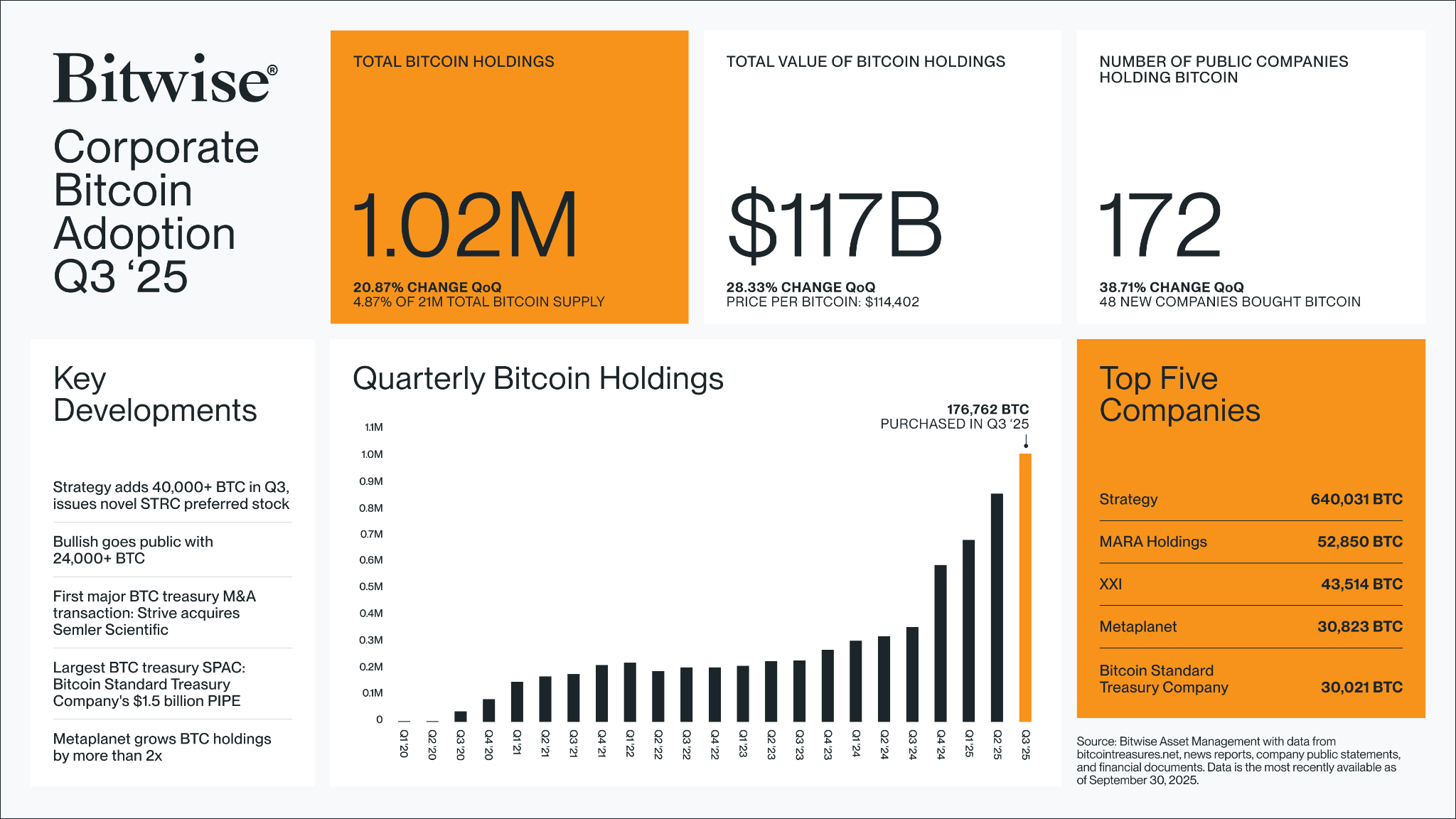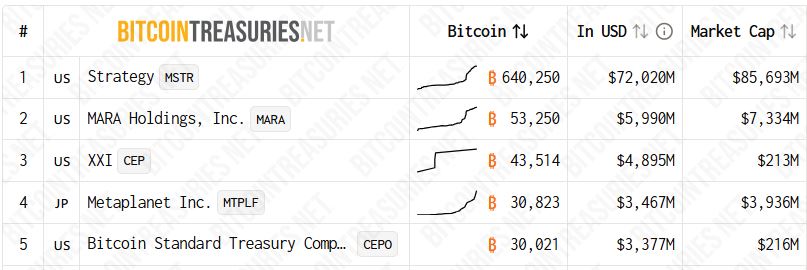Companies holding Bitcoin are increasing markedly: 172 public firms now report Bitcoin on their balance sheets (48 additions in Q3), collectively holding over 1,000,000 BTC valued at about $117 billion—evidence that corporate treasuries are allocating to Bitcoin as a strategic reserve asset.
-
172 public companies hold Bitcoin — 48 new entrants in Q3
-
Total corporate holdings exceed 1,000,000 BTC, representing 4.87% of supply and valued near $117 billion
-
Major holders include Strategy (640,250 BTC) and MARA (53,250 BTC); institutional inflows and ETF demand continue to grow
Companies holding Bitcoin surge: 172 public firms now own BTC—over 1,000,000 coins valued at $117B (up 28% QoQ). Read COINOTAG’s analysis and next steps.
Published: Oct 15, 2025. Updated: Oct 15, 2025. Author: COINOTAG.
What is corporate Bitcoin adoption?
Corporate Bitcoin adoption means public and private companies add Bitcoin to their treasury or balance sheet as a strategic asset rather than for short-term trading. This trend reflects firms using Bitcoin for diversification, inflation hedging, and broader treasury policy, often acquired via over-the-counter (OTC) channels to minimise market impact.
How many public companies currently hold Bitcoin?
According to a Q3 corporate adoption report from Bitwise citing BitcoinTreasuries.NET, 172 companies now list Bitcoin on their treasuries, with 48 new entrants in the quarter. The combined holdings exceed one million BTC—about 4.87% of the total supply—and have an estimated market value near $117 billion, a rise of roughly 28% quarter-on-quarter. Bitwise CEO Hunter Horsley described the figures as “absolutely remarkable” and noted, “People want to own Bitcoin. Companies do too.”

Bitwise’s report indicates that corporate adoption of Bitcoin remains steady. Source: Bitwise / BitcoinTreasuries.NET
Large corporations still want BTC
Market observers and corporate analysts say the acceleration in corporate treasuries signals institutional confidence. Rachael Lucas, an analyst at BTC Markets, noted the growing accumulation suggests “larger players are doubling down, not backing away.” The two largest corporate treasuries remain led by Strategy, holding roughly 640,250 BTC, followed by miner MARA Holdings with about 53,250 BTC.
Lucas added institutional participation is not purely speculative: “Institutional adoption is deepening—they’re not just chasing short-term gains, they’re making a long-term decision on digital assets as part of their treasury strategy.” She also highlighted that increasing regulatory clarity and improving institutional infrastructure are supporting continued adoption.

Strategy has a significant lead among Bitcoin holding companies. Source: BitcoinTreasuries.NET
Supply is being sucked up, so when’s the bull run?
Corporate buys are often executed OTC to limit slippage, which means large accumulations can occur without immediate upward pressure on spot markets. Still, the balance of supply and ordered institutional demand can tighten available float. Edward Carroll, head of markets at MHC Digital Group, commented that the surge in institutional interest will likely create a demand/supply imbalance that “should firmly place upward pressure on price action in the medium-long term.”
That balance faces offsets—profit-taking by long-term holders, derivatives flows, and macro shocks—that can cause volatility and sharp corrections. Reported market production and acquisition rates provide context: miners typically generate roughly 900 BTC per day (per Bitbo), while a separate financial-services report from River found businesses acquiring an average of 1,755 BTC per day in 2025, indicating net institutional absorption of newly mined coins.
Crypto becoming mature
Beyond corporate treasuries, regulated vehicles such as US spot Bitcoin ETFs are expanding access for traditional investors. Recent weekly ETF inflows—$2.71 billion in the latest uptick—underscore strong institutional and retail appetite through familiar, regulated channels. Analysts say these developments are consistent with a maturing market where crypto moves from a speculative niche to a mainstream asset class with institutional-grade participation and infrastructure.
As Lucas put it: “What we’re witnessing is a maturing market. Crypto is evolving from a speculative playground into a legitimate asset class with institutional-grade participation.”
Frequently Asked Questions
How did corporate Bitcoin adoption change in Q3 2025?
In Q3 2025, the number of public companies holding Bitcoin rose by 38%, reaching 172 firms with 48 new entrants. Total corporate holdings surpassed one million BTC and the aggregate value increased about 28% quarter-over-quarter to roughly $117 billion, according to Bitwise and BitcoinTreasuries.NET data.
Why are companies buying Bitcoin now?
Companies buy Bitcoin for treasury diversification, as an inflation hedge, and to offer shareholders exposure to digital assets. Many purchases are made OTC to reduce market impact, and continued regulatory clarity plus growing ETF adoption have encouraged firms to incorporate Bitcoin into long-term treasury strategies.
Key Takeaways
- Corporate adoption is accelerating: 172 public companies hold Bitcoin, with 48 additions in Q3.
- Material holdings and valuation: Corporate treasuries hold over 1,000,000 BTC (~4.87% supply), valued near $117B (up ~28% QoQ).
- Market impact and strategy: OTC purchasing, ETF inflows, and institutional demand are likely to tighten supply, with potential medium- to long-term upward price pressure.
Conclusion
Corporate Bitcoin adoption has moved from intermittent headline buys to a sustained trend: companies holding Bitcoin now represent a significant, measurable portion of market supply. With authoritative data from Bitwise and BitcoinTreasuries.NET and commentary from market professionals at BTC Markets and MHC Digital Group, the evidence points to deeper institutional commitment. COINOTAG will continue to monitor filings, ETF flows, and corporate disclosures to track how this allocation reshapes markets; readers should consider how corporate trends may inform their own treasury and investment strategies.
